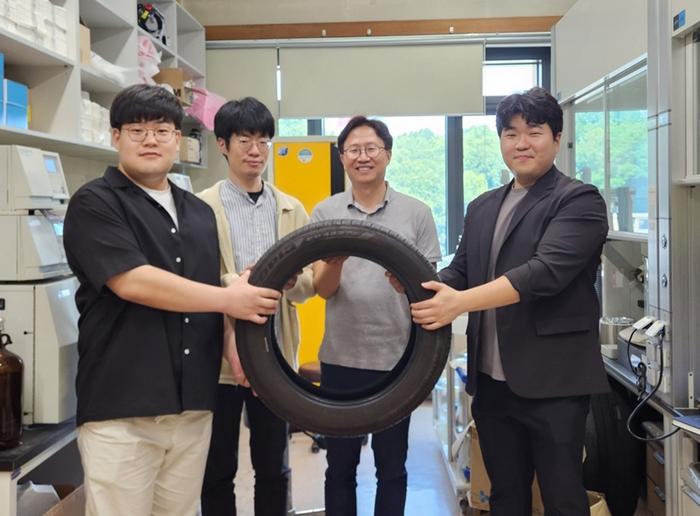
In a groundbreaking advancement poised to revolutionize the recycling industry, scientists at the Korea Advanced Institute of Science and Technology (KAIST) have devised an innovative chemical recycling method that converts discarded waste tires into high-purity cyclic alkenes. This technological leap addresses one of the most pressing environmental challenges— the global accumulation of over 1.5 billion tires annually, which contribute significantly to environmental pollution due to their persistent nature and difficulty in decomposition.
The research team, headed by Professor Soon Hyeok Hong from KAIST’s Department of Chemistry, has tackled the inherent complexities associated with recycling vulcanized rubber. Unlike conventional materials, tires are constructed through vulcanization — a process that forms robust cross-links between rubber polymer chains, fortifying the tires’ durability against heat, pressure, and mechanical stress. While this cross-linked structure provides tires with exceptional performance, it simultaneously creates a formidable obstacle for chemical recycling due to its resistance to breakdown under standard conditions.
Traditional tire recycling approaches, including mechanical recycling and pyrolysis, have faced significant limitations. Mechanical recycling often results in degraded material quality unsuitable for high-value applications, while pyrolysis — the thermal decomposition of polymers at temperatures between 350°C and 800°C — consumes excessive energy and yields complex, low-selectivity hydrocarbon mixtures that lack industrial value. These methods have thus far fallen short of producing economically viable and environmentally sustainable solutions for waste tire management.
.adsslot_ENZ9mnT4OI{ width:728px !important; height:90px !important; }
@media (max-width:1199px) { .adsslot_ENZ9mnT4OI{ width:468px !important; height:60px !important; } }
@media (max-width:767px) { .adsslot_ENZ9mnT4OI{ width:320px !important; height:50px !important; } }
ADVERTISEMENT
Responding to these challenges, Professor Hong’s team engineered a novel dual-catalyst system that precisely manipulates the molecular architecture of vulcanized rubber. The first catalyst initiates a targeted cleavage of the cross-link bonds, effectively depolymerizing the rubber chains by modifying specific chemical linkages. This strategic bond-breaking circumvents the random, high-energy degradation seen in pyrolysis, enabling a more controlled and selective reaction environment.
Concurrently, the second catalyst facilitates a ring-closing metathesis reaction, driving the formation of cyclic alkene compounds from the liberated linear fragments. This catalytic synergy converts complex rubber waste into structurally defined and high-purity cyclic molecules such as cyclopentene and cyclohexene. Remarkably, this chemical process achieves a selectivity rate of up to 92% and yields reaching 82%, underscoring the system’s efficiency and precision.
The industrial implications of these cyclic alkenes are substantial. Cyclopentene is a valuable precursor for the synthesis of new rubber materials, potentially allowing for recycled rubber to re-enter the manufacturing cycle without compromising quality. Cyclohexene serves as an important raw material in nylon fiber production, linking tire waste remediation directly to the textile industry and fostering circular use of resources.
Applied to actual discarded tires, the dual-catalyst system demonstrated exceptional performance. By conducting the catalytic reactions under relatively mild, low-temperature conditions, the method not only reduces energy consumption but also limits the generation of undesirable byproducts. This temperature-controlled approach preserves the molecular integrity of target compounds and distinguishes itself as a sustainable and scalable strategy for the polymer recycling sector.
Beyond tire-derived waste, this catalytic platform exhibits compatibility with diverse synthetic and post-consumer rubber materials. Such versatility suggests broad applicability across multiple industries reliant on rubbers and elastomers, including automotive, footwear, and industrial products. The scalability potential further amplifies its significance as a foundation for circular economy models within polymer science and materials engineering.
From a fundamental chemistry perspective, this advancement exemplifies how sophisticated catalyst design can mediate challenging polymer transformations that were previously deemed impractical or inefficient. By unlocking selective cleavage and ring-closing reactions in cross-linked rubbers, the research pioneers new possibilities for repurposing long-lived polymer waste streams with precision and enhanced value recovery.
Professor Soon Hyeok Hong emphasized the forward-looking goals of the research, stating, “Our findings provide an innovative pathway to chemically recycle post-consumer tires, traditionally regarded as recalcitrant waste. Our ongoing efforts aim to develop next-generation catalysts with even higher efficiencies and to establish the groundwork for industrial commercialization. Ultimately, this foundational chemistry can contribute to addressing the global plastic pollution crisis by expanding the scope of sustainable recycling technologies.”
The study features critical participation from team members including Beomsoon Park, Kyoungil Cho, and Kyungmin Choi, and received funding support from the National Research Foundation of Korea. Their detailed work was formally published on June 18, 2025, in the prestigious journal Chem, marking a significant milestone in polymer chemistry and environmental technology research.
This research also carries commercial implications, as a patent application has been filed to protect the novel catalytic method. Such intellectual property considerations underlie the potential translation of this science into practical recycling facilities, fostering industrial partnerships and incentivizing further innovation.
As global waste tire generation continues to escalate, with existing management solutions struggling to keep pace, the KAIST team’s catalytic approach offers a timely and technically sound alternative. By marrying advanced catalysis with environmental stewardship, the study sets a new benchmark for chemical recycling that could help transform the lifecycle management of durable polymeric materials worldwide.
Subject of Research: Not applicable
Article Title: Catalytic and Selective Chemical Recycling of Post-Consumer Rubbers into Cycloalkenes
News Publication Date: 18-Jun-2025
Web References:
10.1016/j.chempr.2025.102625
References:
Park, B., Cho, K., Choi, K., & Hong, S. H. (2025). Catalytic and Selective Chemical Recycling of Post-Consumer Rubbers into Cycloalkenes. Chem. https://doi.org/10.1016/j.chempr.2025.102625
Image Credits: KAIST Molecular Catalysis Lab
Keywords
Waste tire recycling, chemical recycling, vulcanized rubber, dual catalysis, cyclic alkenes, cyclopentene, cyclohexene, ring-closing metathesis, sustainable polymers, polymer upcycling, environmental pollution, catalytic depolymerization
Tags: advanced recycling methods for rubberchallenges in tire recycling processeschemical recycling of vulcanized rubbercircular economy in rubber industryconverting waste tires into raw materialsenergy-efficient tire recycling techniquesenvironmental impact of tire wastehigh-purity cyclic alkenes productioninnovative tire recycling technologyKAIST tire recycling researchovercoming tire vulcanization issuessustainable waste management solutions



